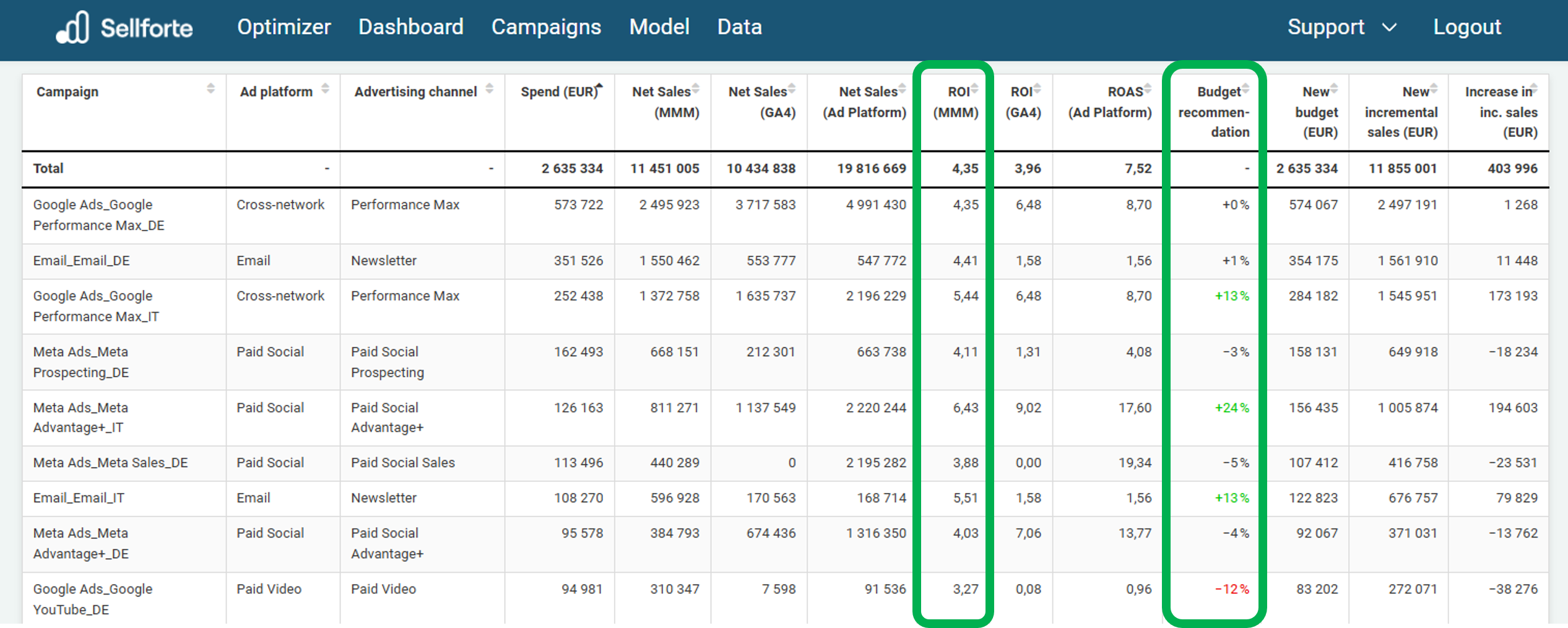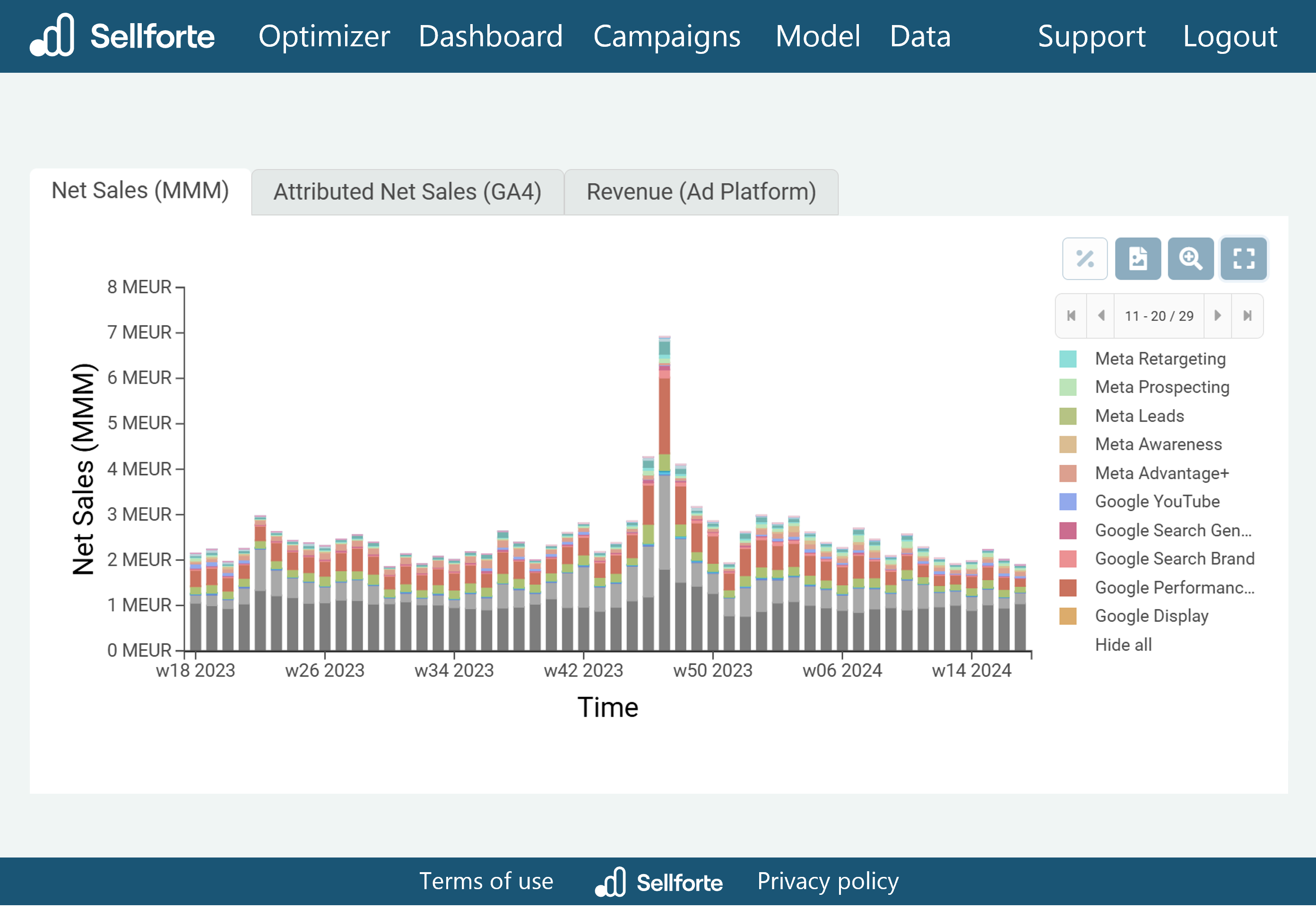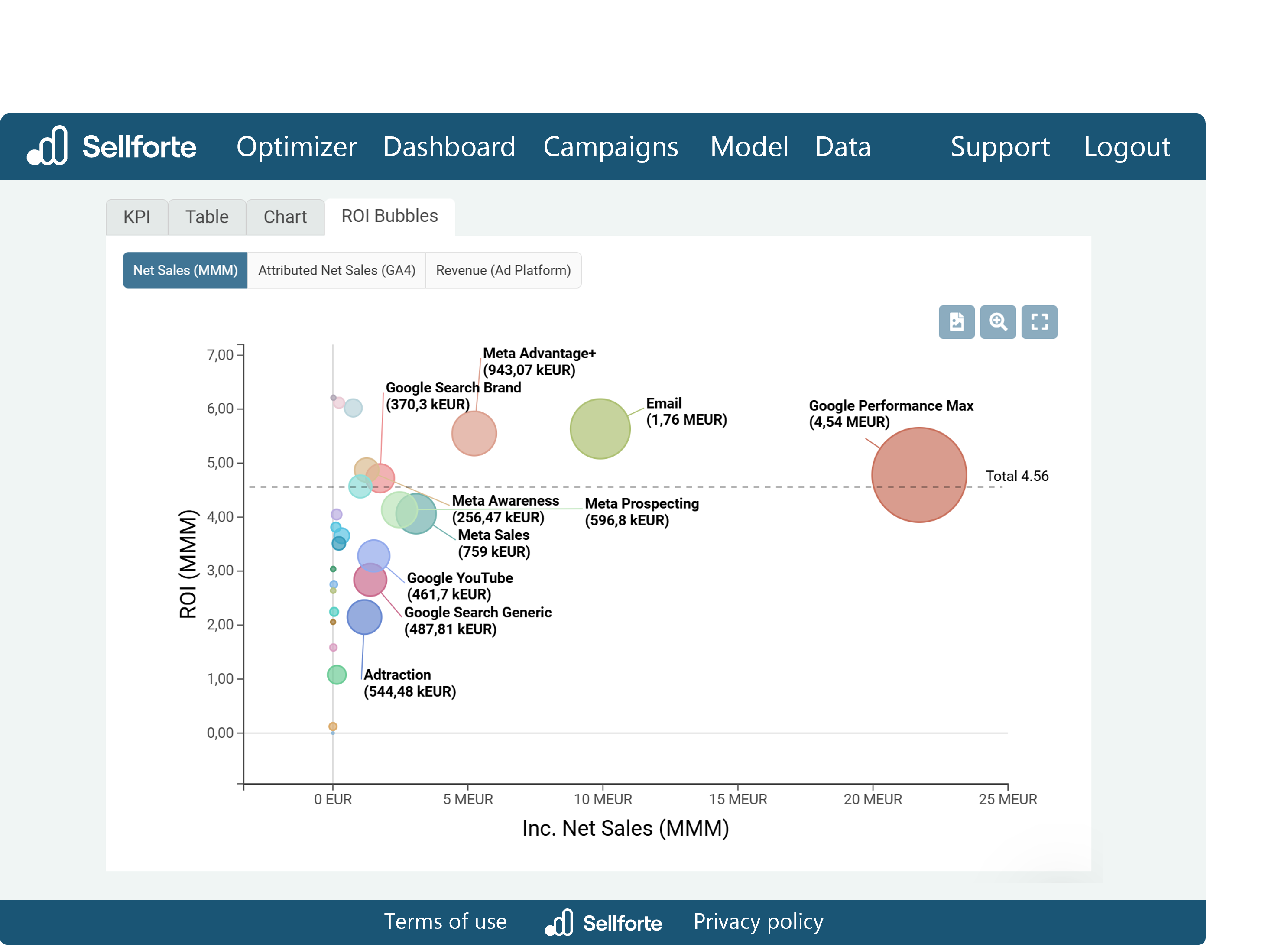What is Marketing Mix Modeling (MMM)? A Complete Guide for Marketers
Marketing Mix Modeling (MMM), sometimes also referred to as Media Mix Modeling, has seen a rapid increase in popularity in the recent years.
And it's clear why. For eCommerce and DTC businesses, it unlocks campaign optimization based on true incremental sales impact of each campaign, instead of using last-click attribution that favors bottom-of-funnel channels. For digital marketing teams working at retailers with both eCommerce and physical store sales, it finally provides visibility into how digital channels are affecting sales in both channels, not just the eCommerce.
We also see industry giants, such as Meta and Google, strongly advocating for MMM, because click-based attribution is not able to capture the full impact of their media, such as Paid Social, Paid Video.
And there's also the privacy-trend: marketers are being pushed towards measurement that does not leverage privacy-sensitive data, and which is resistant to loss of cookies and rise of consent forms.
But what exactly is Marketing Mix Modeling, and how does it work? Let’s dive in.
Why Marketing Mix Modeling Matters for Advertisers
Unlike many other analytics solutions, Marketing Mix Modeling’s business case is extremely simple to evaluate and understand, because MMM provides optimization decisions that are directly impacting revenue and profit.
Based on our research, Marketing Mix Modeling helps eCom/DTC business drive +6.5% more sales (without increasing ad spend), whereas in omnichannel retail the sales improvement potential with same media budget is +1.6%. The image below shows the levers driving the improvement potential for eCom /DTC. Let’s next walk through each improvement lever one by one.
Lever 1: Optimize budget allocation across campaigns
Many marketers might not immediately associate Marketing Mix Modeling (MMM) with campaign-level optimization, assuming MMM is only useful for high-level budget allocation. However, modern MMM solutions have evolved, and most powerful MMMs today offer campaign-level optimization to drive growth. In fact, eCom/DTC brands can unlock 2.9% additional sales by reallocating budgets across campaigns based on MMM insights.
Campaign-level optimization with Next Gen MMMs is exciting, because it enables performance marketing teams to finally transition from biased attribution -based ROAS metrics, to incrementality-based optimization. Below is an example of Sellforte’s campaign dashboard.
 Sellforte Campaign dashboard with ROI and budget recommendation highlighted
Sellforte Campaign dashboard with ROI and budget recommendation highlightedLever 2: Optimize budget allocation across advertising channels
The most known MMM use-case is optimizing media allocation across advertising channels. In our terminology, “advertising channel” refers to the level that is one click deeper within ad platforms. For example, we group Meta campaigns into Prospecting, Retargeting, Awareness, Sales, Advantage+ and so on, and Google Ads campaigns into Performance Max, branded search, non-branded search, display, shopping and so on. Some also refer to these as “tactics”.
Despite being the most common use-case, this is the smallest out of the three levers in this research. The +1.6% revenue increase opportunity for eCom / DTC businesses comes from decreasing or stopping channels with poor performance or high level of saturation and shifting spend to channels which have room to scale.
Lever 3: Optimize budget pacing throughout the year
The third optimization lever, budget pacing, ensures that advertising spend is distributed optimally across weeks, preventing for example overinvestment when demand is naturally low and underinvestment when there’s high level natural demand. Below is an illustration of what optimization outlook can look like for this lever:
What’s wrong with today’s measurement?
The previously mentioned improvements mean that an Omnichannel retailer with $1.2B of annual revenue (median in the study), gets a $19M+ revenue increase.
This is a massive improvement - how is it possible that the current budget are so far from optimal? The single-biggest reason is that digital spend optimization today is primarily done with click-based attribution. As an example, to get the true ROI of Meta Advantage+ campaigns, you might need to multiply Google Analytics 4 -reported ROAS by 7x (based on our research).
How does Marketing Mix Modeling work?
To understand how Marketing Mix Modeling estimates the incremental sales contribution and ROI of each channel and campaign, we need to approach it in layers, which we’ll cover in this chapter:
- All Marketing Mix Models are based on time-series analysis.
- 80%+ of Marketing Mix Models nowadays are based on a specific time-series analysis method: Bayesian Marketing Mix Modeling.
- Only a few MMM platforms, like Sellforte, are Next Gen MMMs, because they leverage advanced modelling methods, such as model calibration, for radically higher quality MMM results.
Time-series analysis: The basic idea behind all Marketing Mix Models
All Marketing Mix Models are given time-series data on sales, media activities, and other factors influencing sales, such as promotions. Marketing Mix Model then uses this data to learn each media channel's sales impact by investigating whether increases in sales coincide with media activities, as illustrated below.
In this illustration, the company activated campaigns on Meta’s platform, which resulted in a sales increase (first peak). On the second sales peak, the company also activated campaigns in Google’s channels, and the sales was even higher. Because the model learned Meta’s effectiveness already from first sales peak, it can estimate impact of Google ads during the second peak, even when Google and Meta ads are active at the same time. While in reality modeling is much more complex, this illustrates the basic idea of estimates incremental impact of media based on time-series data.
What is Bayesian Marketing Mix Modeling?
Bayesian Marketing Mix Modeling, used by 80%+ of MMM vendors and practitioners today, is the golden standard for Marketing Mix Modeling. Bayesian MMM was originally popularized by Google Research in 2017 (see e.g., link), and it has several benefits over legacy models.
One of the main benefits is that the Bayesian methodology enables giving the model knowledge about media’s behavior, even before the modeling has started. This knowledge is given to the model in the form of prior distributions, which indicates the likely range of channel’s ROI to the model.
Additionally, compared to legacy models, Bayesian models produce more robust ROI estimates with limited data, can better handle uncertainty, and can better manage challenges related to overfitting.
Next Gen Marketing Mix Model superpower: Model calibration
While Bayesian approach is already used by 80%+ of Marketing Mix Modeling vendors and practitioners today, model calibration is only only used extensively by the most advanced MMM platforms. Model calibration started slowly gaining popularity in 2023, after Igor Skokan et al. launched their ground-breaking article in Harvard Business Review.
Model calibration is an approach for radically improving the quality of modeling results, by complementing traditional modeling data with other information about media effectiveness, such as experiment results or ROI benchmarks based on attribution data. Instead of using non-informative priors, e.g., “ROI can be anything between 0 and 100”, model calibration uses informative priors to narrow down the likely ROI range already before modeling, e.g., “ROI is between 4 and 5”.
Model calibration significantly improves the ROI estimates for individual channels, but also improves the model’s stability as a whole. But how can we produce informative priors that indicate the ROI is likely within a certain range? This brings us to the next topic.
Next Gen MMM superpower: In-built Causal Attribution Model for generating informative priors
The main assumption in model calibration is that you have strong evidence, which justifies using prior distributions that limit the range of possible ROI estimates. This makes model calibration tricky - you need to be REALLY SURE that the priors given to the model are based on solid evidence.
Most advanced MMM solutions achieve this by integrating a Causal Attribution Model into the modeling workflow. Causal Attribution Model estimates informative priors (i.e., likely ROI distributions) for each channel based on a broad set data. For example, Sellforte’s in-built Causal Attribution Model ingests
- Experiment data: Conversion Lift Tests, Geo Lift Experiments, and other incrementality tests.
- Attribution data: Google Analytics 4 last-click and DDA, Ad platform attribution, and Multi-Touch-Attribution data.
Using this data, Sellforte’s Causal Attribution Model produces informative prior distributions that provide a solid starting for the Bayesian model to estimate final ROI for each channel.
To be clear, none of the beforementioned data can be used directly as priors in the model. Especially attribution data is highly biased, and requires processing before it can contribute to the formation of the prior distribution. This is why Sellforte’s Causal Attribution Model has specialized processing for each type of input data. For example, Sellforte has specialized processing of Geo Lift experiments to truly understand each experiment’s uncertainty intervals and estimated lift.
What are the main outputs from Marketing Mix Modeling (MMM)?
By now, you have in-depth understanding of how Marketing Mix Models operate! But what do Marketing Mix Models actually generate as output? While we covered the typical optimization outputs already in the beginning of this article, let’s walk through some of the most typical analysis outputs of MMMs.
1. Decomposition of sales to base, promotion, media
Marketing Mix Model estimates how much of company's sales was
- Base sales (sales the company would get without media or promotions),
- Incremental sales driven by each channel.
- Promotion-driven sales.
This is typically summarized in a sales decomposition chart, which can be used to understand how impactful marketing activities have been. Below is an illustration of sales decomposition chart:
 Sales decomposition view in Sellforte's dashboard
Sales decomposition view in Sellforte's dashboard2. ROI of each digital channel and offline media
After Marketing Mix Model has estimated the incremental sales impact of each channel and campaign, it can calculate the Return On Investment (ROI) for them. ROI provides an answer to the questions: “If I invest $1 in media, how many dollars do I get back in revenue or margin?” The screenshot from the Sellforte platform shows one way of summarizing ROI, spend, and incremental sales of each channel.
 Bubble chart view in Sellforte's dashboard
Bubble chart view in Sellforte's dashboard3. Response curve for each digital channel and offline media
Now it starts getting interesting, because we are getting closer to optimization. Marketing Mix Modeling provides you with response curves for each channel, which indicate the expected the sales impact of a channel at a certain spend level. Response curves capture the diminishing return effect of marketing: the sales impact of each additional euro/dollar invested to a channel decreases the more you invest into the channel.
Response curves are powerful, because they enable you to analyse the level of saturation in each channel. For example, if you’re getting additional budget and evaluating how to invest it, your decision should not be based on ROI comparison – it should be based on understanding which channel has most room to scale. You might have channels with high ROI, but highly saturated, and channels with lower ROI but lots of room to scale.
As an example, below is an image with response curves for two channels. Channel B has higher ROI, but is more saturated. Channel A has lower ROI but room to scale. This means that additional investments in channel B bring very little incremental sales, while channel A can deliver more incremental sales with additional investments.
What data do Marketing Mix Models use?
To generate high quality outputs, Marketing Mix Models need lots of granular high quality data. Data collection in Marketing Mix Modeling used to be a manual and labour-intensive task, but nowadays Marketing Mix Modeling platforms have in-built data connectors, that automate data deliveries. As an example, in a typical eCom/DTC business onboarding at Sellforte, customers spend 15-30mins to connect their data. Below is an example of Sellforte’s data connector view:
Marketing Mix Models take in three types of data: Time-series modeling da, Attribution data, Experiment data.
Time-series Modeling data
Sales data. Typically, Sellforte gets the sales data with data connectors/integrations directly from an eCommerce platform, such as Shopify, or from a data warehouse, such as Snowflake. Using data connectors enables automated data flows, and getting the most granular sales data possible (daily, product group -level, geo details etc.)
Online Media Data: Sellforte has in-built data connectors to all significant ad platfmors, including Google, Meta, TikTok, Pinterest, Snapchat and so on. This way Sellforte’s model can leverage all relevant metrics, such as like impressions, clicks, conversions, conversions values, and ad spend across your campaigns and channels.
Offline Media Data: This includes traditional advertising like TV, radio, print, and billboards. Marketing Mix Model needs media-specific metrics such rating points, how long the campaigns ran, and how much you spent.
Own Media Data: This is all the data from your own channels, such as SMS and emails.
Promotional data: Promotions are typically major sales drivers, and information about them is important to give to the model.
External Variables: Typical external variables include weather, macroeconomic factors, and data related to seasonal effects.
Attribution data
Attribution data is important in calibrating the Marketing Mix Model. Typical attribution data that Next Gen MMMs use include the following.
Google Analytics 4 (GA4): GA4’s last-click is the most used attribution method, while some might also use GA4’s data-driven attribution.
Multi-touch-attribution (MTA): MTA as a technology has been in decline for some time, but it is still used especially by some of the largest advertisers.
Ad platform attribution: Ad paltform attribution data can be collected with the same dataconnectors that are used to collect advertising data from the platforms.
Experiment data
Data on experiments or incrementality tests is also used in calibrating the Marketing Mix Model. However, experiment data is typically not available for all channels, and there’s businesses who haven’t even started conducting experiments. There are two main types of experiments that are popular while writing this article.
Conversion lift tests. Conversion lift tests are offered by most ad platforms, and include for example Meta’s Conversion Lift test, Google’s Conversion Lift test, TikTok’s Split test. Their test setup resembles randomized controlled trials (RCTs), which are typically considered one of the best methods for estimating causal effects. The main idea in conversion lift tests is to divide the target audience into test group and control group, and derive insights about marketing’s incrementality by comparing the two groups. Typically, the test group sees the specific ad to be tested, and the control group sees a blank space.
Geography-based Lift experiment (or Geo tests): Geo tests use a similar concept of creating control and test groups, but here we are talking about geographies. For example, you could divide U.S. states or U.S. Designated Market Areas (DMAs), into test and control areas. While conversion lift tests typically produce standardized outputs that include estimated value and its confidence intervals, geo tests can be more challenging to analyze, as the method lacks a similar level of standardization. For this reason, Sellforte’s MMM platform has in-built capabilities for analysing Geo tests so that they can be used in model validation and calibration.
How to choose a Marketing Mix Modeling tool or platform?
Sellforte’s Buyers Guide to MMM Tools and Platforms provides a full in-depth explanation of what to look for when evaluating Marketing Mix Modeling tools or platforms. Below you'll find the summary with icon ✅ indicating a basic feature in most MMMs, and icon 💎 indicating features you typically find from most advanced MMM platforms, Next Gen MMMs.
1. Choose an MMM Platform That Helps You Drive More Sales
Your first objective is to ensure that the Marketing Mix Modeling solution has optimization capabilities that help you drive more sales. Here's a checklist from basic features to Next Gen features:
Basic features:
✅ Advertising channel-level optimization
Next Gen MMM features:
💎 Campaign-level optimization
💎 Optimal weekly budget pacing
2. Choose an MMM Platform That Produces High Quality Results
When you’re confident that the platform you’re evaluating has the right optimization capabilities, it’s time to check whether you can trust the Marketing Mix Modeling results enough to start acting based on the recommendations.
I’ll be honest with you: there’s a lot of Marketing Mix Models generating low quality, non-sensical, modeling results in the market. Why? Generating MMM results is easier than ever before, for example with open-source modeling libraries like Meridian and Robyn. Today, it can even be done by a non-technical person without knowledge of statistics or econometrics, just by following simple tutorials. At the same time, the challenge of building MMMs that produce high quality results has remained, because MMM datasets are noisy and can have strong multicollinearity effects that need to be managed, as Google Research pointed out already in 2017.
Luckily, there’s a few things you can easily check from any MMM vendor, that make it likely that the MMM produces high quality results. Here's a checklist from basic features to Next Gen features:
Basic features:
✅ Statistical model validation
✅ Bayesian approach
Next Gen MMM features:
💎 MMM is calibrated with informative priors
💎 In-built Causal Attribution Model for generating informative priors
💎 Advanced model validation based on model outputs
3. Choose an MMM platform that is easy to test & start with
Now that you're convinced that you have an MMM, which helps you with the right optimization decisions and produces high quality modeling results, you should evaluate the effort of getting started with the platform. This is a top we at Sellforte are especially passionate about - making MMMs easy to use and start without compromising quality of MMM results. Here's a checklist from basic features to Next Gen features:
Basic features:
✅ Data connectors
Next Gen MMM features:
💎 Delivers high quality results in 1-2 weeks
💎 Provides a Free Trial
4. Other considerations
Build or Buy. If you are in a position where you have the capabilities and financial muscle to invest millions of dollars to build a Marketing Mix Modeling platform described in this article, as well as patience to wait for its development, consider yourself lucky - you are in a unique situation! While building an own MMM platform gives you the ultimate freedom and flexibility, most companies decide to purchase subscription to an MMM platform from a specialized vendor, after evaluating the cost and effort of building and operating an MMM platform themselves.
Consulting projects or SaaS. Since Sellforte was founded in 2017, we've witnessed a major transition from consultant-delivered MMM PowerPoints to modern SaaS tools. If you're still considering MMM consulting projects in 2025, you should ensure you have a strong rationale and conviction why your consulting partner can deliver superior service against modern MMM SaaS vendors.
Conclusion and Key takeaways
In short:
- MMM-based on optimization can drive a significant improvement in sales, +6.5% for eCom/DTC
- MMM technology has advanced to a level where it can support tactical campaign optimization, in addition to higher level budget allocation decisions
- Testing an MMM platform today is fast & easy: Connect your data in 15-30mins, get MMM results in 1-2 weeks (example of an eCom/DTC onboarding)
If you’re interested in testing Marketing Mix Modeling, start a free trial with Sellforte.
Further Reading
Sellforte guides
-
Calibrating Marketing Mix Models with Experiments and Attribution data. Link
-
From Last-click to Marketing Mix Modeling (MMM): Unlock +6.5% more sales. Link
-
23 Marketing Mix Modeling Tools for Accelerating Growth in 2025. Link
-
How to measure Meta correctly? GA4 vs. MTA vs. MMM. Link
-
Advertising response curves: What are they and why do you need them? Link
-
How Much Ad Spend Is Needed for Marketing Mix Modeling? Link
Research papers and whitepapers
-
Challenges And Opportunities In Media Mix Modeling (2017, Google - Chan et al.) Link
-
Bayesian Methods for Media Mix Modeling with Carryover and Shape Effects (2017, Google - Jin et al.) Link
-
Geo-level Bayesian Hierarchical Media Mix Modeling (2017, Google - Sun et al.) Link
-
Hierarchical Bayesian Approach to Improve Media Mix Models Using Category Data (2017, Google, Wang et. al) Link
-
Bayesian Time Varying Coefficient Model with Applications to Marketing Mix Modeling (2021, Uber - Ng et al.) Link
-
Hierarchical Marketing Mix Models with Sign Constraints (2020, Cheng et al.) Link
-
Bayesian Hierarchical Media Mix Model Incorporating Reach and Frequency Data (2023, Google - Zhang et al.) Link
-
Media Mix Model Calibration With Bayesian Priors (2024, Zhang et al.) Link


You May Also Like
These Related Stories

